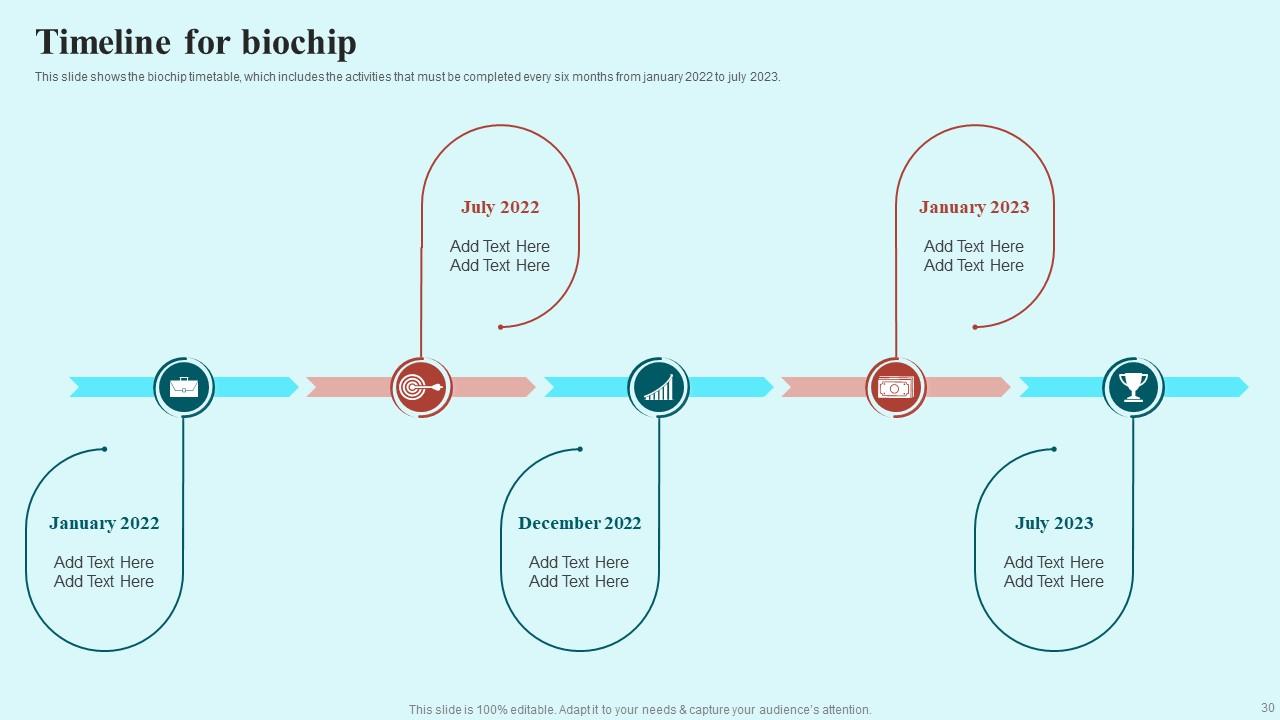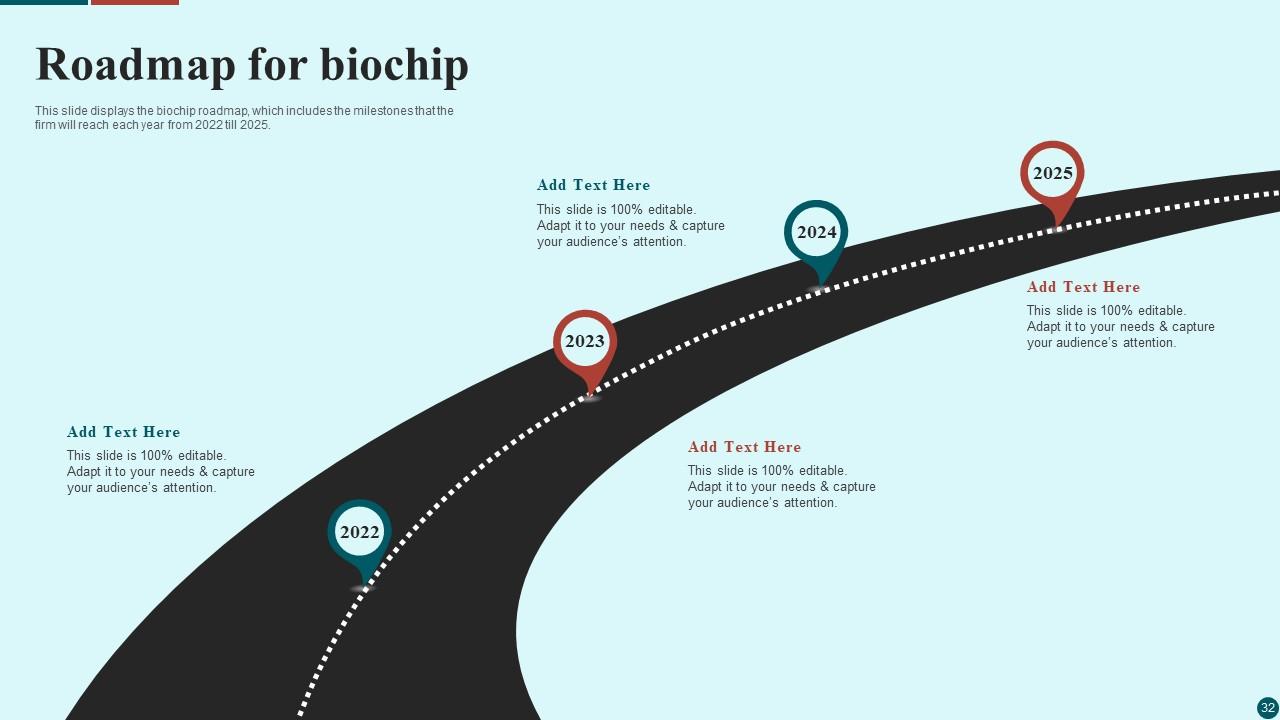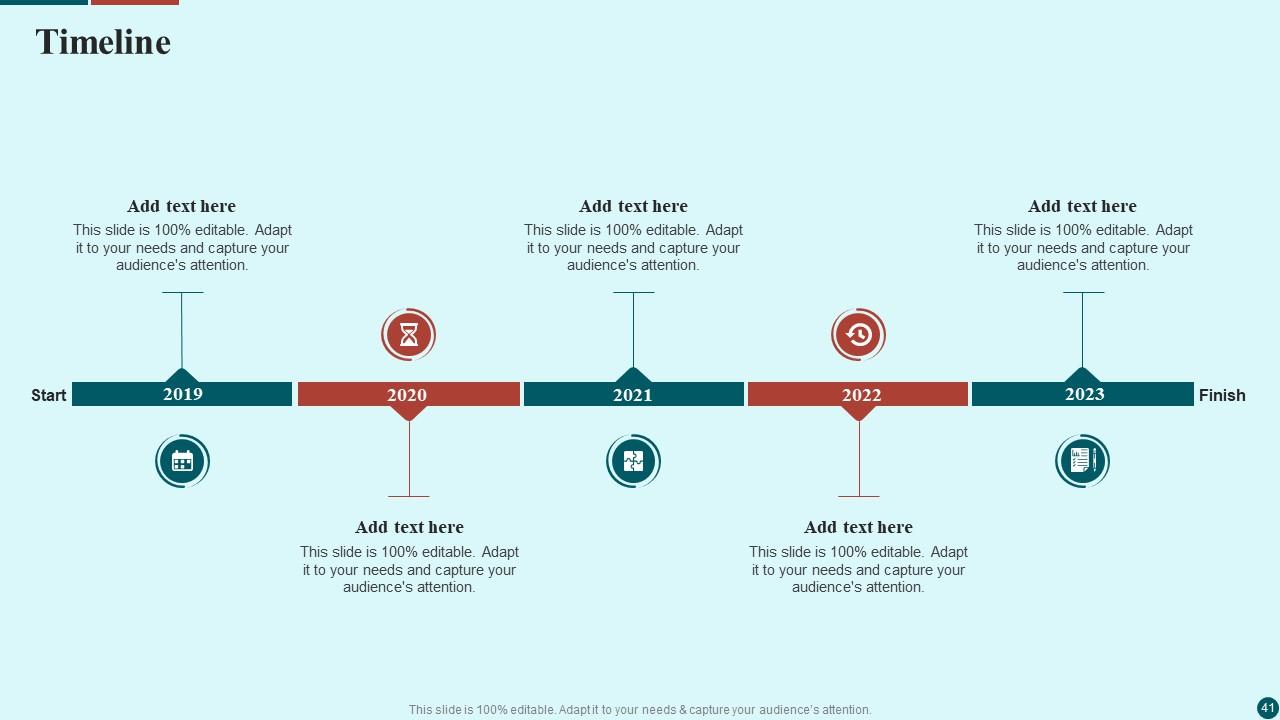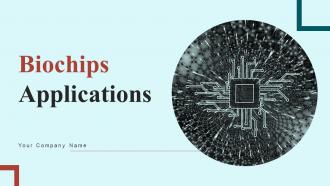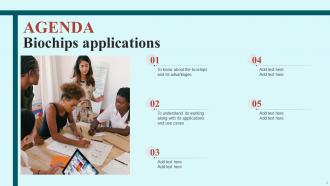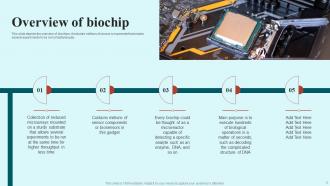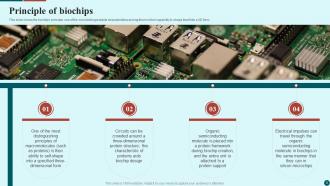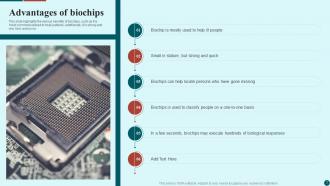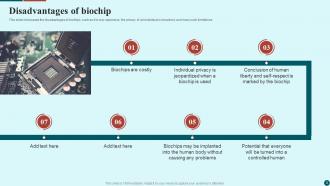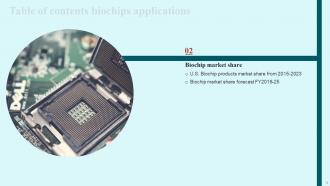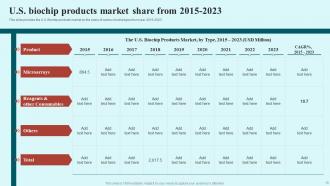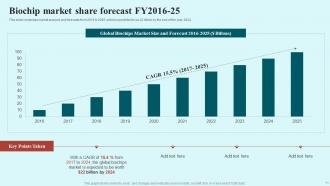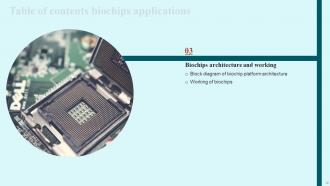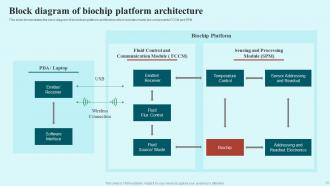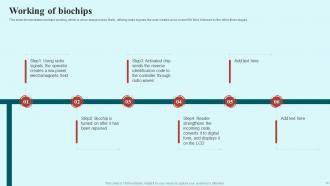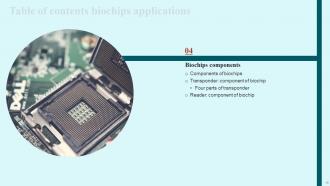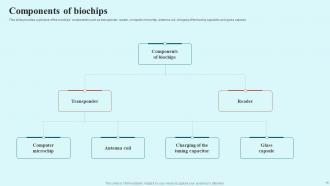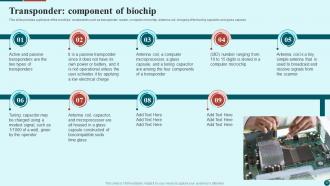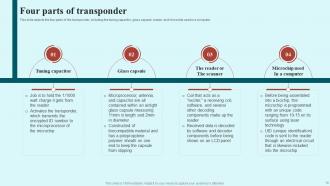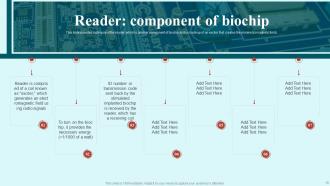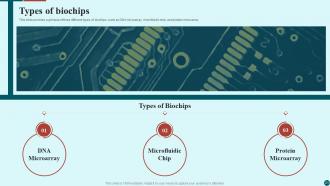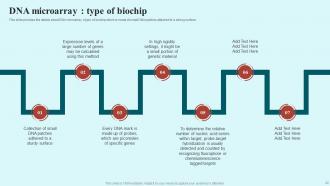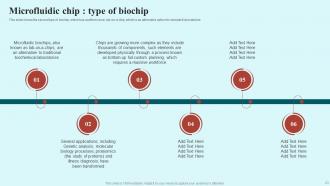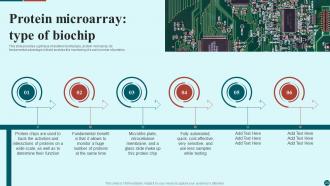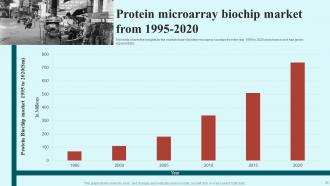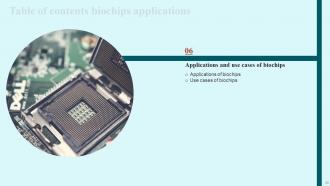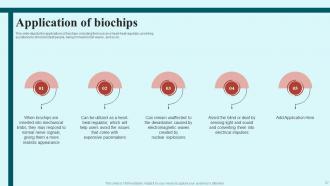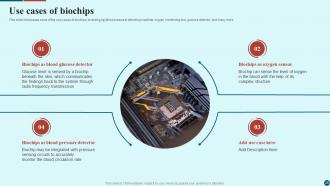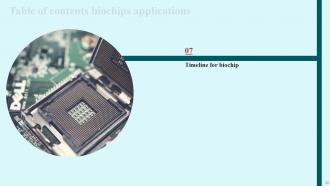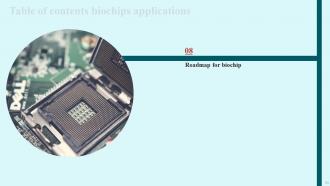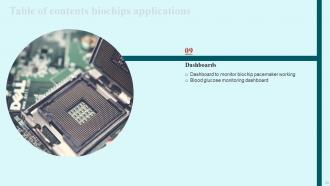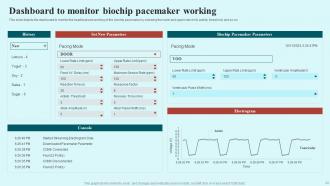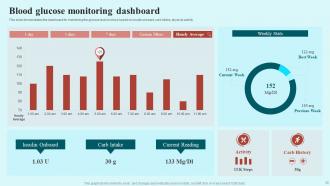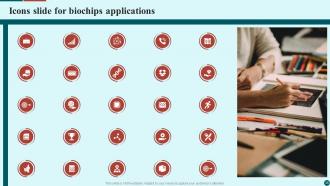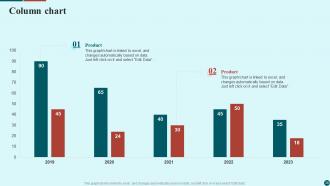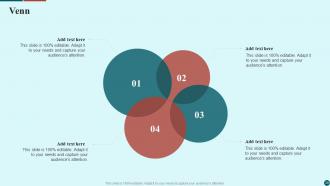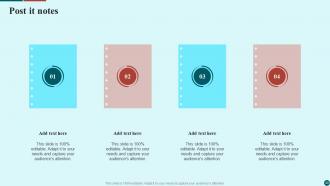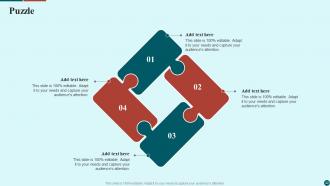Biochips Applications Powerpoint Presentation Slides
Biochips contain millions of sensor components or biosensors in the gadget, allowing several experiments to run simultaneously for higher throughput in less time. Check out our competently designed Biochips Applications template that highlights details about its overview, advantages, working, application, use cases, etc. This PPT template displays principles of Biochips, US Biochips products market share, Biochips market share forecast, working of Biochips, etc. Moreover, this Biochips application template presents a block diagram of Biochips platform architecture, its components, transponder and four parts, reader details, and more. The PowerPoint presentation even exhibits the information regarding types of Biochips, DNA micro array, microfluidic chip, protein micro-array, Biochips market details from 1995-2022, etc. Furthermore, the bio micro-array device template highlights applications and use cases of Biochips, the timeline for Biochips, the roadmap, and more. One can even illustrate details for the dashboard to monitor Biochips pacemaker working, blood glucose monitoring dashboard, and more. Customize this 100 percent editable template based on your requirements. Download it now.
You must be logged in to download this presentation.
PowerPoint presentation slides
Enthrall your audience with this Biochips Applications Powerpoint Presentation Slides. Increase your presentation threshold by deploying this well-crafted template. It acts as a great communication tool due to its well-researched content. It also contains stylized icons, graphics, visuals etc, which make it an immediate attention-grabber. Comprising fourty three slides, this complete deck is all you need to get noticed. All the slides and their content can be altered to suit your unique business setting. Not only that, other components and graphics can also be modified to add personal touches to this prefabricated set.
People who downloaded this PowerPoint presentation also viewed the following :
Content of this Powerpoint Presentation
Slide 1: This slide displays the title Biochips Applications.
Slide 2: This slide displays the title AGENDA.
Slide 3: This slide exhibit table of content.
Slide 4: This slide exhibit table of content- About biochips.
Slide 5: This slide depicts the overview of biochips; it includes millions of sensor components that enable several experiments to be run simultaneously.
Slide 6: This slide shows the biochips’ principle, one of the most distinguishable characteristics among them is their capability to shape itself into a 3D form.
Slide 7: This slide highlights the various benefits of biochips.
Slide 8: This slide showcases the disadvantages of biochips, such as it is very expensive; the privacy of an individual is breached, and many such limitations.
Slide 9: This slide exhibit table of content- Biochip market share.
Slide 10: This slide provides the U.S. Biochip products market on the basis of various biochip types from year 2015-2023.
Slide 11: This slide comprises market analysis and forecasts from 2016 to 2025, which is predicted to be 22 billion by the end of the year 2024.
Slide 12: This slide exhibit table of content- Biochips architecture and working.
Slide 13: This slide demonstrates the block diagram of blockchain platform architecture which includes mainly two components FCCM and SPM.
Slide 14: This slide demonstrates biochips' working, which is a four-step process; firstly, utilizing radio signals, the user creates a low power EM field, followed by the other three stages.
Slide 15: This slide exhibit table of content- Biochips components
Slide 16: This slide provides a glimpse of the biochips’ components such as transponder, reader, computer microchip, antenna coil.
Slide 17: This slide provides a glimpse of the biochips’ components such as transponder, reader, computer microchip, antenna coil.
Slide 18: This slide depicts the four parts of the transponder, including the tuning capacitor, glass capsule, reader, and microchip used in a computer.
Slide 19: This slide provides a glimpse of the reader, which is another component of biochip and is made up of an exciter that creates the em(electromagnetic field).
Slide 20: This slide exhibit table of content- Various biochips.
Slide 21: This slide provides a glimpse of three types of biochips: DNA microarray, microfluidic chip, and protein microarray.
Slide 22: This slide provides the details about DNA microarray, a type of biochip which is made of small DNA patches attached to a strong surface.
Slide 23: This slide shows the second type of biochip, which has another name, lab-on-a-chip, which is an alternative option for standard laboratories.
Slide 24: This slide provides a glimpse of another biochip type, protein microarray; its fundamental advantage is that it enables the monitoring of a vast number of proteins.
Slide 25: This slide shares the insights for the market share of protein microarray biochips from the year 1995 to 2020 and shows how it has grown exponentially.
Slide 26: This slide exhibit table of content- Applications and use cases of biochips
Slide 27: This slide depicts the applications of biochips.
Slide 28: This slide showcases some of the use cases of biochips, including bp(blood pressure) detecting machine, oxygen monitoring tool, glucose detector, and many more.
Slide 29: This slide exhibit table of content- Timeline for biochip.
Slide 30: This slide shows the biochip timetable, which includes the activities that must be completed every six months from january 2022 to july 2023.
Slide 31: This slide exhibit table of content- Roadmap for biochip.
Slide 32: This slide displays the biochip roadmap, which includes the milestones that the firm will reach each year from 2022 till 2025.
Slide 33: This slide exhibit table of content- Dashboards.
Slide 34: This slide depicts the dashboard to monitor the heartbeat and working of the biochip pacemaker.
Slide 35: This slide demonstrates the dashboard for monitoring the glucose level in blood-based on insulin onboard, carb intake, physical activity.
Slide 36: This is the icons slide.
Slide 37: This slide presents title for additional slides.
Slide 38: This slide showcase Column chart for different products.
Slide 39: This slide display Venn.
Slide 40: This slide depicts posts for past experiences of clients.
Slide 41: This slide exhibit Timeline.
Slide 42: This slide shows puzzle for displaying elements of company.
Slide 43: This is thank you slide & contains contact details of company like office address, phone no., etc.
Biochips Applications Powerpoint Presentation Slides with all 48 slides:
Use our Biochips Applications Powerpoint Presentation Slides to effectively help you save your valuable time. They are readymade to fit into any presentation structure.
FAQs
Biochips are small devices that have millions of sensor components capable of conducting several experiments simultaneously. Their most distinguishable characteristic is their ability to shape themselves into a 3D form.
The benefits of biochips include their ability to conduct multiple experiments simultaneously, high accuracy, and quick results. On the other hand, the disadvantages include high costs, potential privacy concerns, and other limitations.
The components of a biochip include a transponder, reader, computer microchip, and antenna coil. The transponder has four parts: the tuning capacitor, glass capsule, reader, and microchip. The reader creates an electromagnetic field, and the computer microchip processes the data collected by the antenna coil.
There are three types of biochips: DNA microarray, microfluidic chip, and protein microarray. DNA microarrays are made of small DNA patches attached to a strong surface, microfluidic chips are an alternative option for standard laboratories, and protein microarrays enable the monitoring of a vast number of proteins. They are used in various applications such as blood pressure detection, oxygen monitoring, glucose detection, etc.
Biochips have several applications, including in the medical field for disease diagnosis and treatment, environmental monitoring, and drug discovery.
-
The customer care of SlideTeam is very responsive. I was having a payment issue and they fixed it for me in no time.
-
I can say with full confidence that all your business, academic, or professional work requirements will be sufficed with SlideTeam. Their gallery is as rich as 2Million+!!































